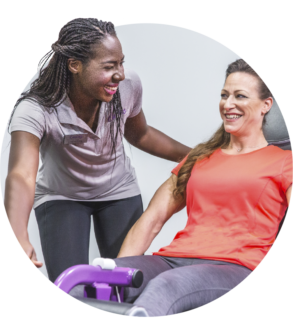How Much Exercise Is Too Much?
If you’re wondering how many days you should engage in a full body workout at Curves, or for how long you should exercise, you’re in luck. The United States Office of Disease Prevention and Health Promotion has clear guidelines1. They say, for major health benefits, aim for at least 150 minutes (2 hours, 30 minutes) of moderate-intensity aerobic activity, or 75 minutes (1 hour, 15 minutes) of vigorous-intensity aerobic activity each week. Or, you can do a combination of both. One minute of vigorous-intensity activity is equal to 2 minutes of moderate-intensity activity.
What’s the difference between moderate and vigorous exercise?
At Curves, the traditional strength training workout, as well as the Body Basics, Balance, and Walking classes are considered moderate-intensity. Other moderate-intensity activities include brisk walking (3 miles per hour or faster, but not race-walking), water aerobics, bicycling (slower than 10 miles per hour), tennis (doubles), ballroom dancing, and general gardening.
Vigorous exercise2 includes activities such as race walking, jogging, or running; swimming laps; tennis (singles); jumping rope; bicycling at 10 miles per hour or faster; hiking uphill or with a heavy backpack; aerobic dancing; and heavy gardening that includes continuous digging or hoeing. To go for a vigorous workout at Curves, go for higher-intensity Cardio, Dance, and Boxing classes.
If you’re aiming for a workout plan that helps you lose weight, you may have to increase your activity level. That may mean starting from scratch with a gym workout or walking regimen. Or it may mean taking your current exercise routine up a few notches. You can do as much as 300 minutes of moderate-intensity activity or 150 minutes of vigorous exercise per week.
Beyond 300 minutes of moderate activity or 150 minutes of vigorous activity, you may be doing your body more harm than good. You can either reach this tipping point by exercising too much without rest or failing to nourish your exercising body with a healthy eating plan. Called overtraining syndrome (OTS), too much exercise can hinder your fitness and lead to an injury that could permanently sideline you from your whole body workout.
Signs your workouts may be bordering on OTS
According to the American Council on Exercise3, here are signs your exercise routine may be bordering on OTS:
- You feel weaker – You’ve increased the intensity and length of your workouts, but you feel weaker than you did before. When you are overtraining, you will stop seeing desired fitness results.
- You feel tired – Your workouts make you feel tired for the rest of the day. Overtraining can make the workout plan that used to leave you energized making you want to crawl back into bed. You may also notice it takes longer for your heart rate to return to normal once you’ve finished your exercise.
- You’re grumpy – Increased levels of stress hormones, leading to mood swings, trouble concentrating, and irritability.
- You can’t sleep – The stress hormones that can result from OTS can prevent you from winding down when it’s time to go to sleep. Too little sleep can lead to even more stress and depressed mood.
- You’re not hungry – The hormone imbalance can suppress your appetite at a time when your body needs a healthy diet more than ever. And since malnourishment can make OTS worse, a vicious cycle can ensure.
- You’re getting injured or sick – Any pain that doesn’t get better in two weeks indicates a possible injury. OTS ups your risk of injury during your full body workout, and it also ups your chances of getting upper respiratory infections and other illnesses. Exercising to excess can also lead to low bone mineral density.
- You’ve got other health problems – These may include nutrient deficiencies, such as iron deficiency anemia, which can sap your energy and hinder performance during your workout. Other medical conditions linked to OTS include problems with the cardiovascular, gastrointestinal, endocrine, nervous and reproductive systems.
Your Curves Coach is there to lead you through every gym workout. With your Curves Coach success is within reach. Visit ‘Why Curves‘ to find out more about Curves women’s only gyms and our full body workout on the Curves Circuit, or find your local Curves and sign up today! Find your local Curves here!
**The information contained above is presented in summary form only and intended to provide broad consumer understanding and knowledge of various healthcare topics. It should not be used in place of a visit, call, consultation or advice of your doctor or other healthcare provider. You should discuss any dietary changes or supplement usage with your doctor, and should not discontinue any prescription medications without first consulting your doctor.
Sources








